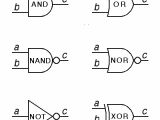As we all know the microprocessor is the 'brain' of the modern digital computer, but have you ever wondered how a piece of silicon manages to process information so accurately and at such a high speed rate? The answer lies behind the basic building blocks of the processor, the logic gates, and a special type of information processing technique invented in the middle of the 1800s by George Boole, called Boolean logic.
Basically, Boolean logic operates only in the binary system by following a couple of simple rules. There are about seven simple logic gates that need to be studies in order to understand the full picture of how Boolean logic and computer microprocessors work by combining logical gates in a single electronic circuit that may contain several million transistors.
We'll start with the simplest of all - the NOT gate, or the logical inverter (see bottom image, lower left corner). The NOT gate has one entrance and one exit and has the role of inverting logic bits. This basically means that when a '1' logic bit is applied on the 'a' terminal for example, the 'c' terminal must produce a '0' logic bit. The situation is reversed when '0' logic is applied on the 'a' terminal by forcing the 'c' terminal to output a '1' logic bit. Inversion is one of the basic operations in Boolean logic.
Another logic gate of critical importance is the AND gate (upper left corner), which practically designates an operation similar to multiplying. As you can see, the AND gate has two input terminals (a,b) and an output terminal (c). In fact the number of input terminals is unlimited. Boolean logic puts it very simple. If one of the input values is '0' logic, then the value of the other bits is irrelevant and the output will always produce a '0' logic. A '1' logic bit is present at the output terminal, only when all input bits are equal to '1' logic.
The OR gate, operates according to the logic that if one of the input terminals bears a '1' logic bit, then the 'c' terminal will always produce a '1'. The situation reverses when all of the input bits are '0' logic. The NAND (NOT AND) and NOR (NOT OR) gates can be imagined as an AND respectively an OR gate to whose output terminals a NOT gate (see image for symbols) is connected. Their logic is basically identical to that of AND and OR gates, but the output value is always reversed.
The last two significant logic gates are the XOR and XNOR gates, both of which can be constructed by using the basic logic gates (similar to the case of NAND and OR gates). XOR outputs a '1' logic only when a single input value equals '1' logic. In other cases the output produces a '0' bit. XNOR gates produce XOR reverse values.
By combining logic gates in logic ways a whole range of electronic devices can be constructed, starting with flip-flops, simple memories, counters, Random Access Memories all the way up to highly complex logical circuitry such as computer processors. You would be amazed at how simple some of these devices are.

 14 DAY TRIAL //
14 DAY TRIAL // 
